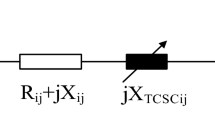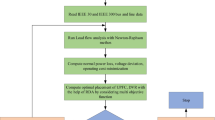Abstract
Nowadays, the power system security investigation performs a vital part so as to step up the system security with a view to keep at bay the prospect of system breakdown scenarios. With the ever-zooming power transfer, the hassles encountered by the power system have assumed alarming proportions of added intricacy with dwindling security of the power system in the power industry. In the paper, an enhanced optimal technique is proposed for solving the optimal power flow (OPF) issues with uncertainties. An enhanced technique is the Yin–Yang Pair Optimization algorithm, which is based on maintaining a balance between exploration and exploitation of the search space. Initially, the OPF is analyzed with the N–R approach and after that, the FACTS devices-based power flow is analyzed. The FACTS devices are considered as STATCOM, UPFC and IPFC devices, after the placement of FACTS devices as contingency is relived. Initially, the multi-objective function is defined and the power losses, voltage deviation, investment cost and fuel cost are analyzed. For the OPF analysis, multi-objective functions are considered under the uncertainty period. The proposed method is tested with the IEEE 30- and IEEE 118-bus system, and the corresponding line loading, line outage, generator outage, both outage and bus voltage impact are analyzed. To verify the performances of the proposed method, it is compared with the traditional methods such as Particle Swarm Optimization, Firefly Algorithm, ant Lion Optimization and Bat Optimization. The proposed method is implemented in MATLAB platform and tested with the various cases.












Similar content being viewed by others
Explore related subjects
Discover the latest articles, news and stories from top researchers in related subjects.Data availability
Associated with no data.
References
Acharjee P (2016) Optimal power flow with UPFC using security constrained self-adaptive differential evolutionary algorithm for restructured power system. Int J Electr Power Energy Syst 76:69–81
Alhejji A, Hussein ME, Kamel S, Alyami S (2020) Optimal power flow solution with an embedded center-node unified power flow controller using an adaptive grasshopper optimization algorithm. IEEE Access 8:119020–119037
Basu M (2008) Optimal power flow with FACTS devices uses differential evolution. Int J Electr Power Energy Syst 30(2):150–156
Basu M (2011) Multi-objective optimal power flow with FACTS devices. Int J Energy Convers Manag 52(2):903–910
Bhattacharyya B, Kumar S (2016) Loadability enhancement with FACTS devices using gravitational search algorithm. Int J Electr Power Energy Syst 78:470–479
Bhattacharyya B, Raj S (2016) Swarm intelligence-based algorithms for reactive power planning with Flexible AC transmission system devices. Int J Electr Power Energy Syst 78:158–164
Biswas PP, Arora P, Mallipeddi R, Suganthan PN, Panigrahi BK (2021) Optimal placement and sizing of FACTS devices for optimal power flow in a wind power integrated electrical network. Neural Comput Appl 33(12):6753–6774
Buraimoh E, Ariyo FK, Omoigui M, Davidson IE (2018) Investigation of combined SVC and TCSC versus IPFC in enhancing power system static security. Int J Eng Res Africa 40:119–135
Dasu B, Sivakumar M, Srinivasarao R (2019) Interconnected multi-machine power system stabilizer design using whale optimization algorithm. Prot Control Modern Power Syst 4(1):1–11
Dorile PO (2021) Grid strength assessment trough QV modal analysis and maximum loadability of a wind-dominated power system using PQ regions (Doctoral dissertation, University of Arkansas)
Ebeed M, Kamel S, Jurado F (2018) Optimal power flow using recent optimization techniques. Classical and recent aspects of power system optimization. Academic Press, Cambridge, pp 157–183
El-Araby ESE, Yorino N (2018) Reactive power reserve management tool for voltage stability enhancement. IET Gener Transm Distrib 12(8):1879–1888
Fayaz F, Pahuja GL (2020) ANN-based relaying algorithm for protection of SVC-compensated AC transmission line and criticality analysis of a digital relay. Recent Adv Comput Sci Commun (Formerly: Recent Patents Comput Sci) 13(3):381–393
Haes Alhelou H, Hamedani-Golshan ME, Njenda TC, Siano P (2019) A survey on power system blackout and cascading events: Research motivations and challenges. Energies 12(4):682
Hedman KW, Neill RPO, Fisher EB, Oren SS (2009) Optimal transmission switching with contingency analysis. IEEE Trans Power Syst 24(3):1577–1586
Herenčić L, Ilak P, Rajšl I (2019) Effects of local electricity trading on power flows and voltage levels for different elasticities and prices. Energies 12(24):4708
Jordehi AR (2015) Brainstorm optimization algorithm (BSOA): an efficient algorithm for finding optimal location and setting of FACTS devices in electric power systems. Int J Electr Power Energy Syst 69:48–57
Kumar BV, Ramaiah V (2020) Enhancement of dynamic stability by optimal location and capacity of UPFC: a hybrid approach. Energy 190:116464
Lal C, Balachander K (2020) Design and ANALYSIS of PSS and SVC controller using crossover GSA approach
Li B, Xiao G, Lu R, Deng R, Bao H (2019) On feasibility and limitations of detecting false data injection attacks on power grid state estimation using D-FACTS devices. IEEE Trans Industr Inf 16(2):854–864
Mahdad B, Srairi K, Bouktir T (2010) Optimal power flow for large-scale power system with shunts FACTS using efficient parallel GA. Int J Electr Power Energy Syst 32(5):507–517
Nadeem M, Imran K, Khattak A, Ulasyar A, Pal A, Zeb MZ, Khan AN, Padhee M (2020) Optimal placement, sizing and coordination of FACTS devices in transmission network using whale optimization algorithm. Energies 13(3):753
Nguyen TT, Mohammadi F (2020) Optimal placement of TCSC for congestion management and power loss reduction using multi-objective genetic algorithm. Sustainability 12(7):2813
Niknam T, Narimani MR, Azizipanah-Abarghooee R (2012) A new hybrid algorithm for optimal power flow considering prohibited zones and valve point effect. Int J Energy Convers Manag 58:197–206
Norouzi N, de Rubens GZ, Choupanpiesheh S, Enevoldsen P (2020) When pandemics impact economies and climate change: exploring the impacts of COVID-19 on oil and electricity demand in China. Energy Res Soc Sci 68:101654
Pandiarajan K, Babulal CK (2016) Fuzzy harmony search algorithm based optimal power flow for power system security enhancement. Int J Electr Power Energy Syst 78:72–79
Parastvand H, Bass O, Masoum MA, Chapman A, Lachowicz S (2020) Cyber-security constrained placement of FACTS devices in power networks from a novel topological perspective. IEEE Access 8:108201–108215
Pravallika LD, Rao BV (2016) Flower Pollination Algorithm based optimal setting of TCSC to minimize the transmission line losses in the power system. Int J Proc Compu Sci 92:30–35
Punnathanam V, Kotecha P (2016) Yin-Yang-pair optimization: a novel lightweight optimization algorithm. Int J Eng Appl Artif Intell 54:62–79
Punnathanam V, Kotecha P (2017) Multi-objective optimization of Stirling engine systems using Front-based Yin-Yang-Pair Optimization. Int J Energy Convers Manag 133:332–348
Ravindra S, Suresh CV, Sivanagaraju S, Reddy VCV (2017) Power system security enhancement with unified power flow controller under multi-event contingency conditions. Ain Shams Eng J 8(1):9–28
Roberson D, Kim HC, Chen B, Page C, Nuqui R, Valdes A, Macwan R, Johnson BK (2019) Improving grid resilience using high-voltage DC: strengthening the security of power system stability. IEEE Power Energy Magaz 17(3):38–47
Sang Y, Sahraei-Ardakani M (2019) Effective power flow control via distributed FACTS considering future uncertainties. Electr Power Syst Res 168:127–136
SinghMukherjee PRV, Ghoshal SP (2015) Particle swarm optimization with an aging leader and challenger’s algorithm for optimal power flow problem with FACTS devices. Int J Electr Power Energy Syst 64:1185–1196
Sreejith S, Simon SP, Selvan MP (2015) Analysis of FACTS devices on security constrained unit commitment problem. Int J Electr Power Energy Syst 66:280–293
Vural MA, Tumay M (2007) Mathematical modeling and analysis of a unified power flow controller: a comparison of two approaches in power flow studies and effects of UPFC location. Int J Electr Power Energy Syst 29(8):617–629
Waskle S, Patidar ML (2020) A review on UPFC power compensation with power generation smart grid
Yadav, Vivek and Ghoshal SP (2018) Optimal power flow for IEEE 30 and 118-bus systems using Monarch Butterfly optimization. In Proceedings IEEE conference on technologies for smart-city energy security and power (ICSESP), pp.1–6
Zaidi AH, Sunderland K, Conlon M (2019) Role of reactive power (STATCOM) in the planning of distribution network with higher EV charging level. IET Gener Transm Distrib 13(7):951–959
Zhang Y, Chen C (2006a) A novel power injection model of IPFC for power flow analysis inclusive of practical constraints. IEEE Trans Power Syst 21(4):1550–1556
Zhang Y, Zhang Y, Wu B, Zhou J (2006b) Power injection model of STATCOM with control and operating limit for power flow and voltage stability analysis. Int J Electr Power Syst Res 76(12):1003–1010
Zhu S, Wu Q, Jiang Y, Xing W (2021) A novel multi-objective group teaching optimization algorithm and its application to engineering design. Comput Ind Eng 155:107198
Funding
There is no funding provided to prepare the manuscript.
Author information
Authors and Affiliations
Corresponding author
Ethics declarations
Conflict of interest
There is no conflict of interest between the authors regarding the manuscript preparation and submission.
Ethical approval
This article does not contain any studies with human participants or animals performed by any of the authors.
Informal consent
Informed consent was obtained from all individual participants included in the study.
Additional information
Publisher's Note
Springer Nature remains neutral with regard to jurisdictional claims in published maps and institutional affiliations.
Rights and permissions
About this article
Cite this article
Amarendra, A., Srinivas, L.R. & Rao, R.S. Power system security enhancement in FACTS devices based on Yin–Yang pair optimization algorithm. Soft Comput 26, 6265–6291 (2022). https://doi.org/10.1007/s00500-022-07002-1
Accepted:
Published:
Issue Date:
DOI: https://doi.org/10.1007/s00500-022-07002-1




